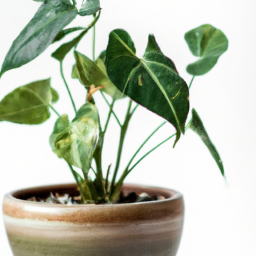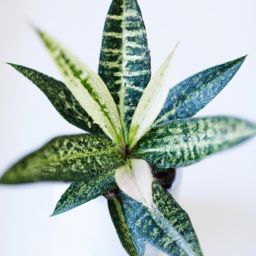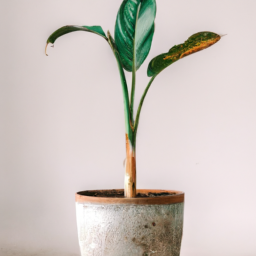
Are you looking to add some greenery to your indoor space but don’t have much natural light? You’re in luck! In this blog post, we’ll explore a variety of indoor plants that don’t need sunlight to thrive. Whether you have a windowless room or just want to brighten up a dark corner, these plants are perfect for adding a touch of nature to your home. So let’s dive in and discover some low-light-loving plants that will bring life to any space, no sunlight required!
Benefits of Low-Light Indoor Plants
As an expert in indoor plants that don’t need sunlight, I am excited to share with you the numerous benefits of incorporating low-light plants into your home. These plants not only add beauty and greenery to your space but also come with a host of health benefits. Let’s explore the advantages of having low-light indoor plants in your home.
Improves Air Quality
One of the key benefits of low-light indoor plants is their ability to improve air quality. Plants naturally absorb carbon dioxide and release oxygen through the process of photosynthesis. This helps to purify the air in your home by removing toxins and pollutants. Low-light plants such as snake plants, spider plants, and peace lilies are particularly effective at filtering out harmful chemicals like formaldehyde and benzene.
In addition to releasing oxygen, indoor plants also release moisture into the air through a process called transpiration. This can help to increase humidity levels in your home, which is beneficial for your respiratory health, especially during the dry winter months. By having low-light plants in your space, you can create a healthier indoor environment for you and your family.
Furthermore, studies have shown that indoor plants can help to reduce stress and anxiety levels. The presence of greenery has a calming effect on our minds and can improve our overall well-being. By incorporating low-light plants into your home, you can create a more relaxing and peaceful environment that promotes mental clarity and positivity.
Easy to Care For
Another advantage of low-light indoor plants is that they are generally easy to care for, making them perfect for beginners or those with a busy lifestyle. These plants require minimal sunlight and can thrive in low-light conditions, making them ideal for rooms with limited natural light. Some popular low-light plants that are easy to care for include pothos, philodendron, and ZZ plants.
Low-light plants also tend to be more forgiving when it comes to watering, as they are more tolerant of dry soil conditions. This means you don’t have to worry about overwatering your plants, which can be a common issue for indoor plant owners. With proper care and occasional watering, low-light plants can thrive and continue to bring beauty and greenery to your space.
Additionally, low-light indoor plants are known for their ability to adapt to different environments and conditions. Whether you have a small apartment or a large house, these plants can easily fit into any space and enhance the aesthetic appeal of your home. With a wide variety of low-light plants to choose from, you can find the perfect plant that suits your style and preferences.
Enhances Decor
Low-light indoor plants are not only beneficial for your health but also serve as decorative elements that can enhance the overall look of your home. These plants come in a variety of shapes, sizes, and colors, allowing you to create a unique and personalized indoor garden that reflects your style and personality.
You can place low-light plants in decorative pots and containers to add a touch of greenery to any room. Whether you prefer hanging plants, trailing vines, or compact foliage, there are plenty of options to choose from when it comes to low-light indoor plants. By strategically placing these plants in different areas of your home, you can create a harmonious and inviting atmosphere that brings nature indoors.
Furthermore, low-light plants can be used to fill empty corners, brighten up dark spaces, or add a pop of color to neutral interiors. Whether you’re looking to create a cozy reading nook, a serene bedroom retreat, or a vibrant living room, low-light plants can help you achieve the desired ambiance and style. With a little creativity and imagination, you can transform your home into a green oasis that is both beautiful and beneficial.

Top 5 Indoor Plants That Thrive in Low-Light Conditions
Peace Lily
Peace lilies are popular indoor plants known for their beautiful white flowers and dark green leaves. They are perfect for low-light conditions and can even thrive in rooms with no windows. Peace lilies are also great air purifiers, removing toxins such as formaldehyde and benzene from the air.
How to Care for Peace Lily:
To care for a peace lily, place it in a spot with indirect sunlight and water it once a week. Make sure the soil is well-drained and keep the plant away from drafts or cold temperatures. You can also mist the leaves occasionally to increase humidity.
Peace lilies are low-maintenance plants that do not require a lot of attention. They are perfect for beginners or busy individuals who want to enjoy the beauty of indoor plants without the hassle of constant care.
Overall, peace lilies are a great choice for low-light environments and can bring a touch of elegance to any room in your home.
Snake Plant
Snake plants, also known as mother-in-law’s tongue, are hardy indoor plants that can survive in low-light conditions. They have tall, upright leaves with a striking appearance, making them a popular choice for modern and minimalist interiors.
How to Care for Snake Plant:
Snake plants are very low-maintenance and can survive with minimal care. They prefer indirect sunlight but can also thrive in low-light environments. Water them sparingly, allowing the soil to dry out between waterings.
Snake plants are known for their air-purifying qualities, removing toxins such as formaldehyde and benzene from the air. They are also drought-tolerant, making them a great choice for forgetful or busy plant owners.
Overall, snake plants are a great option for adding a touch of greenery to your home without the need for direct sunlight.
ZZ Plant
The ZZ plant is a popular indoor plant known for its glossy, dark green leaves and low-light tolerance. It is a great choice for beginners or those with limited natural light in their homes.
How to Care for ZZ Plant:
ZZ plants thrive in low-light conditions but can also tolerate brighter light. Water them sparingly, allowing the soil to dry out between waterings. They are drought-tolerant and can survive with minimal care.
ZZ plants are also known for their air-purifying qualities, removing toxins such as xylene and toluene from the air. They are a great choice for offices or bedrooms where air quality is a concern.
Overall, ZZ plants are a stylish and low-maintenance option for adding greenery to your home without the need for direct sunlight.
Spider Plant
Spider plants are popular indoor plants known for their long, arching leaves and air-purifying qualities. They can thrive in low-light conditions and are easy to care for, making them a great choice for beginners or busy plant owners.
How to Care for Spider Plant:
Spider plants prefer indirect sunlight but can also tolerate low-light environments. Water them regularly, keeping the soil evenly moist but not waterlogged. They are also easy to propagate, producing baby spider plants that can be potted and grown into new plants.
Spider plants are great air purifiers, removing toxins such as formaldehyde and xylene from the air. They are also safe for pets, making them a pet-friendly choice for indoor greenery.
Overall, spider plants are a versatile and attractive option for adding greenery to your home without the need for direct sunlight.
Cast Iron Plant
The cast iron plant is a tough and hardy indoor plant that can survive in low-light conditions. It has dark green, leathery leaves that can withstand neglect and low light, making it a great choice for those with limited natural light in their homes.
How to Care for Cast Iron Plant:
Cast iron plants prefer low-light conditions but can also tolerate brighter light. Water them sparingly, allowing the soil to dry out between waterings. They are drought-tolerant and can survive with minimal care.
Cast iron plants are low-maintenance and can thrive in a variety of indoor environments. They are great for adding a touch of greenery to dark corners or rooms with limited sunlight.
Overall, cast iron plants are a tough and resilient option for indoor greenery that can thrive in low-light conditions.

Tips for Caring for Indoor Plants That Don’t Require Sunlight
Choosing the Right Plants
When it comes to choosing indoor plants that don’t need sunlight, there are several options to consider. One popular choice is the snake plant, also known as Sansevieria. This hardy plant can thrive in low light conditions and only needs to be watered occasionally. Another great option is the ZZ plant, which has glossy green leaves and can tolerate neglect. The peace lily is another excellent choice for low light environments, as it can bloom even in dimly lit rooms.
It’s important to consider the specific lighting conditions in your home when choosing indoor plants. Some plants may need a bit of natural light to thrive, while others can survive in almost total darkness. Be sure to read up on the specific care requirements for each plant before making a decision.
When it comes to caring for indoor plants that don’t need sunlight, proper watering is key. Overwatering can be just as harmful as underwatering, so it’s important to find the right balance. Most low light plants prefer to dry out slightly between waterings, so be sure to let the soil dry out before watering again. It’s also a good idea to use a well-draining potting mix to prevent water from pooling at the bottom of the pot.
Providing Adequate Humidity
In addition to proper watering, indoor plants that don’t need sunlight also require adequate humidity to thrive. Many indoor plants are native to tropical environments, where humidity levels are much higher than in most homes. To mimic these conditions, you can place a humidifier near your plants or group them together to create a microclimate with higher humidity.
Another option is to mist your plants regularly with a spray bottle filled with water. This can help to increase humidity levels around the plant and prevent the leaves from drying out. Be sure to use room temperature water when misting your plants, as cold water can shock the roots and leaves.
If you notice that the leaves of your indoor plants are turning brown or crispy, it may be a sign that the humidity levels are too low. Consider moving your plants to a bathroom or kitchen, where humidity levels are naturally higher, or invest in a humidity tray to help maintain adequate moisture levels.
Preventing Pest Infestations
One of the biggest challenges when caring for indoor plants that don’t need sunlight is preventing pest infestations. Pests such as spider mites, aphids, and mealybugs can quickly take over a plant if left unchecked, so it’s important to be proactive in your pest control efforts.
One effective way to prevent pest infestations is to regularly inspect your plants for signs of pests or damage. Look for tiny webs, sticky residue, or holes in the leaves, as these can all be indicators of a pest problem. If you do notice pests on your plants, there are several natural remedies you can try, such as spraying the leaves with neem oil or wiping them down with a mixture of water and dish soap.
Another important step in preventing pest infestations is to quarantine new plants before introducing them to your existing collection. This can help to prevent the spread of pests from one plant to another and give you time to treat any infestations before they become a serious problem.
By following these tips for caring for indoor plants that don’t need sunlight, you can create a thriving indoor garden that brightens up your home without the need for natural light. Remember to choose the right plants for your specific lighting conditions, provide adequate humidity, and prevent pest infestations to keep your plants healthy and happy.
Key Takeaways of this article
If you’re looking to add some greenery to your home but don’t have a lot of natural light, fear not! There are plenty of indoor plants that thrive in low-light conditions. Some popular options include the snake plant, pothos, and peace lily. These plants are not only easy to care for, but they also help purify the air in your home.
Snake plants, also known as mother-in-law’s tongue, are great for beginners as they require minimal maintenance and can survive in almost any lighting conditions. Pothos, with their trailing vines, are perfect for adding a touch of green to shelves or hanging baskets. Peace lilies are not only beautiful with their white flowers, but they also help remove toxins from the air. So, even if your home doesn’t get a lot of sunlight, you can still enjoy the benefits of having indoor plants.
FAQ Roundup:
Q1. What are some indoor plants that don’t need sunlight?
A1. Some indoor plants that thrive in low-light conditions include snake plants, pothos, peace lilies, spider plants, and ZZ plants. These plants are great options for areas in your home that don’t receive a lot of natural light.
Q2. How often should I water indoor plants that don’t need sunlight?
A2. It’s important to let the soil of your low-light indoor plants dry out between waterings to prevent root rot. Check the moisture level of the soil by sticking your finger in about an inch deep. Water your plants only when the top layer of soil feels dry to the touch.
Q3. Can indoor plants survive without any sunlight at all?
A3. While most indoor plants do need some amount of light to survive, there are some varieties that can tolerate very low light conditions. However, it’s still important to provide them with some indirect or artificial light to ensure they stay healthy and continue to grow.
Q4. What are some tips for caring for indoor plants that don’t need sunlight?
A4. To care for indoor plants that don’t need sunlight, make sure to dust their leaves regularly to help them absorb more light. Also, avoid overwatering as this can lead to root rot. Finally, consider rotating your plants occasionally to ensure all sides receive some light.
Q5. Are there any indoor plants that can purify the air and don’t need sunlight?
A5. Yes, there are several indoor plants that can help purify the air while thriving in low-light conditions. Some examples include peace lilies, snake plants, and spider plants. These plants not only add beauty to your space but also help improve air quality.

James Wong is a renowned ethnobotanist, plant scientist, and local television presenter. With a passion for demystifying plant science, he is known for translating complex botanical concepts into practical advice for everyday plant enthusiasts. James’s expertise spans from traditional gardening to cutting-edge plant technologies, making his insights accessible and informative.


